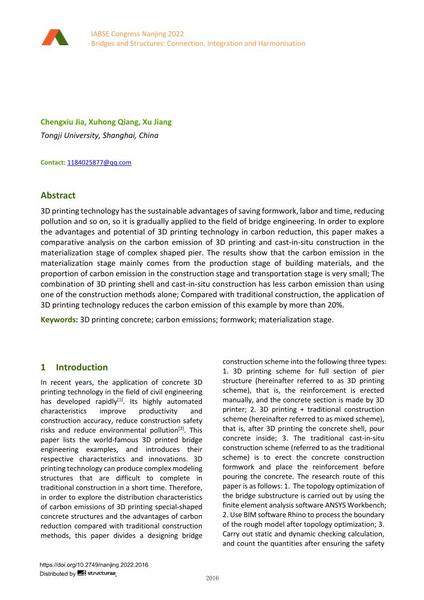Comparative Analysis of Carbon Emission of Special-Shaped Concrete Pier Constructed by 3D Printing and Traditional Construction

|
|
|||||||||||
Bibliographic Details
| Author(s): |
Chengxiu Jia
(Tongji University, Shanghai, China)
Xuhong Qiang (Tongji University, Shanghai, China) Xu Jiang (Tongji University, Shanghai, China) |
||||
|---|---|---|---|---|---|
| Medium: | conference paper | ||||
| Language(s): | English | ||||
| Conference: | IABSE Congress: Bridges and Structures: Connection, Integration and Harmonisation, Nanjing, People's Republic of China, 21-23 September 2022 | ||||
| Published in: | IABSE Congress Nanjing 2022 | ||||
|
|||||
| Page(s): | 2016-2023 | ||||
| Total no. of pages: | 8 | ||||
| DOI: | 10.2749/nanjing.2022.2016 | ||||
| Abstract: |
3D printing technology has the sustainable advantages of saving formwork, labor and time, reducing pollution and so on, so it is gradually applied to the field of bridge engineering. In order to explore the advantages and potential of 3D printing technology in carbon reduction, this paper makes a comparative analysis on the carbon emission of 3D printing and cast-in-situ construction in the materialization stage of complex shaped pier. The results show that the carbon emission in the materialization stage mainly comes from the production stage of building materials, and the proportion of carbon emission in the construction stage and transportation stage is very small; The combination of 3D printing shell and cast-in-situ construction has less carbon emission than using one of the construction methods alone; Compared with traditional construction, the application of 3D printing technology reduces the carbon emission of this example by more than 20%. |
||||
| Keywords: |
formwork carbon emissions 3D printing concrete materialization stage
|
||||
| Copyright: | © 2022 International Association for Bridge and Structural Engineering (IABSE) | ||||
| License: | This creative work is copyrighted material and may not be used without explicit approval by the author and/or copyright owner. |
||||
